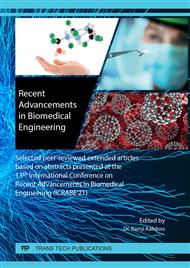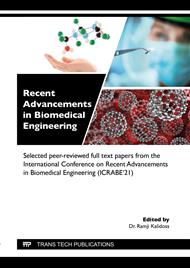[1]
M. Orth, S. Bellosta, Cholesterol: its regulation and role in central nervoussystem disorders, Cholesterol, 2012 (2012)1-19.
DOI: 10.1155/2012/292598
Google Scholar
[2]
R. Ji, L. Wang, G. Wang, X. Zhang, Synthesize thickness copper (I) sulfidenanoplates on copper rod and it's application as nonenzymatic cholesterolsensor, Electrochim. Acta 130 (2014) 239–244.
DOI: 10.1016/j.electacta.2014.02.155
Google Scholar
[3]
R. Ahmad, N. Tripathy, S.H. Kim, A. Umar, A. Al-Hajry, Y.-B. Hahn, Highperformance cholesterol sensor based on ZnO nanotubes grown on Si/Agelectrodes, Electrochem. Commun. 38 (2014) 4–7.
DOI: 10.1016/j.elecom.2013.10.028
Google Scholar
[4]
H. Wei, E. Wang, Nanomaterials with enzyme-like characteristics(nanozymes): next-generation artificial enzymes, Chem. Soc. Rev. 42 (2013)6060–6093.
DOI: 10.1039/c3cs35486e
Google Scholar
[5]
R. Rathinam, T. Brindha, M. Petchiammal and M. Ibrahim, Photo-Electrocatalytic Degradation of aqueous Rhodamine-B dye using Titanium electrodes coated with RuO2/IrO2/TaO2, Indian Journal of Environmental protection, 41 (2021) 1365-1371.
DOI: 10.14233/ajchem.2021.23330
Google Scholar
[6]
C.-L. Hsu, C.-W. Lien, C.-W. Wang, S.G. Harroun, C.-C. Huang, H.-T. Chang,Immobilization of aptamer-modified gold nanoparticles on BiOCl nanosheets:tunable peroxidase-like activity by protein recognition, Biosens. Bioelectron.75 (2016) 181–187.
DOI: 10.1016/j.bios.2015.08.049
Google Scholar
[7]
U. Saxena, A.B. Das, Nanomaterials towards fabrication of cholesterolbiosensors: key roles and design approaches, Biosens. Bioelectron. 75 (2016)196–205.
DOI: 10.1016/j.bios.2015.08.042
Google Scholar
[8]
H. Zhang, Y. Xia, Ratiometry, wavelength, and intensity: triple signal readoutfor colorimetric sensing of mercury ions by plasmonic cu2-xSe nanoparticles, ACS Sens. (2016).
DOI: 10.1021/acssensors.5b00275
Google Scholar
[9]
M. Umadevi, R. Rathinam, S. Poornima, T. Santhi, and S. Pattabhi, Electrochemical Degradation of Reactive Red 195 from its Aqueous Solution using RuO2/IrO2/TaO2 Coated Titanium Electrodes, Asian Journal of Chemistry, 33 (2021) 1919–(1922).
DOI: 10.14233/ajchem.2021.23330
Google Scholar
[10]
X. Zheng, Y. Su, Y. Chen, R. Wan, M. Li, H. Huang, X. Li, Carbon nanotubes affectthe toxicity of CuO nanoparticles to denitrification in marine sediments byaltering cellular internalization of nanoparticle, Sci. Rep. 6 (2016) 27748.
DOI: 10.1038/srep27748
Google Scholar
[11]
R. Rathinam and M. Govindaraj, Photo electro catalytic Oxidation of Textile Industry Wastewater by RuO2/IrO2/TaO2 Coated Titanium Electrodes, Nature Environment and Pollution Technology, 20 (2020) 1069-1076.
DOI: 10.46488/nept.2021.v20i03.014
Google Scholar



